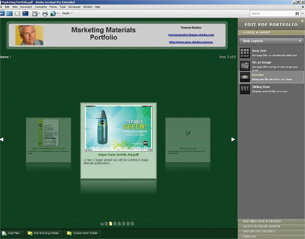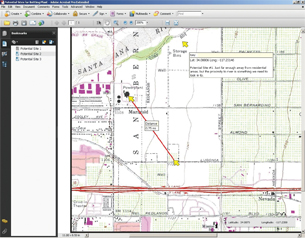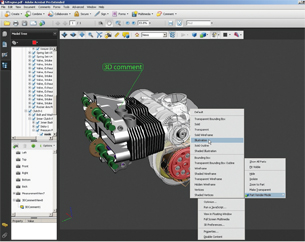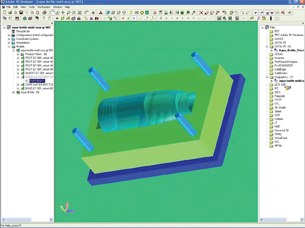Teaching a Talented Acrobat New Tricks
PDF Portfolios and embedded video lead a list of new features in Adobe Acrobat 9 Pro Extended, the best Acrobat release ever.
Latest News
December 4, 2001
By David Cohn
 PDF Portfolios in all versions of Acrobat 9 let you easily combine multiple documents into a single PDF file with professional-looking navigation tools. |
Adobe Systems has once again introduced a new version of its Acrobat software that may be the most significant upgrade in years. While there’s not as much new 3D functionality as in the previous release, the new version offers innovative and enhanced features that will benefit all users.
We reviewed Adobe Acrobat 9 Pro Extended, the new name for the top product level (formerly Acrobat 3D). It incorporates all of the features found in Acrobat 9 Standard and Acrobat 9 Pro while adding 3D capabilities as well as the ability to convert a variety of video formats into Flash.
After the major redesign in the previous release, users will be happy to learn that the user interface is largely unchanged from Acrobat 8 (see DE January 2008). All of the new tools are nicely integrated into the program’s Tasks toolbar. We’ll leave the 3D enhancements until later and focus first on all of the other new features.
PDF Portfolios
One of the most exciting new additions is PDF Portfolios, which lets you combine multiple documents—including Microsoft Office files, images, and video—into a single PDF file. Portfolios can include professional-looking navigation tools to help users find their way through sets of files. You can also search for text within the various files in the portfolio.
Building a PDF Portfolio is easy: You click the Combine button and select Assemble PDF Portfolio to open a new, empty portfolio. You can then add files to the portfolio using drag-and-drop from Windows Explorer, or using the Add Files button at the bottom of the Acrobat window. Once files are in your portfolio, you can easily convert Microsoft Office documents to PDF or media files to Flash-enabled video by right-clicking. You can modify the portfolio’s appearance by selecting one of the available layouts; add a welcome page that can include Flash content, text, and graphics; and add a header complete with a company logo and other information that always appears across the top of the portfolio.
When you’ve finished designing the portfolio, you publish and save it as a PDF file. We were able to quickly create a PDF Portfolio using the Revolve layout style that looked a lot like the CoverFlow interface in Apple’s iTunes.
 New PDF Map capabilities in Acrobat 9 Pro Extended retain meta data and coordinates in imported geospatial files. You can then mark locations and measure distances between points on the map. |
Videos, presentations, & version compare
Another new feature in Acrobat 9 Pro Extended is the ability to convert most popular video file formats, such as QuickTime (MOV) and Windows Media Video (WMV) to Flash files that can be included in a PDF file. All content in the PDF file can then be viewed by anyone with the free Adobe Reader 9, eliminating the need to use additional video players. When you add the video to a PDF file, you can select the video frame you want to use as the image that’s visible before the movie plays and also adjust optional settings such as the video quality and resolution, insert chapter points, and determine what actions launch the video.
Previously you could publish PowerPoint presentations as a PDF file, but Acrobat 9 Pro Extended now includes Adobe Presenter, a media authoring tool that lets you create professional, high-quality, on-demand presentations and publish them to a single PDF file that anyone with the free Adobe Reader can play back. Presentations can include audio, video, and even interactive quizzes.
A panel in Adobe Presenter lets you browse slides—by slide outline or thumbnails—as well as any speaker notes added to slides. You can also search for specific content. Finished presentations can be distributed as stand-alone PDF files or included in a PDF Portfolio.
Yet another new capability is the new Compare Documents command, which lets you open two PDF files you want to compare and create a summary document with all the differences highlighted. You can compare images, text, and tables and immediately identify what is different. You can even use this to compare documents from programs that don’t otherwise support a compare capability. For example, you could convert two versions of a PowerPoint presentation to PDF and quickly see all the differences.
Online site aids collaboration
All three versions of Acrobat 9 provide access to capabilities for collaborating live within a PDF document—enabled by working with Acrobat.com, a new online suite of Adobe-hosted services. For example, you can use the new Send and Collaborate Live command to upload documents to the Acrobat site and then invite others to collaborate. Once collaborators have logged on to the site, you can synchronize views so that any change made to the view on one computer causes the others to change to the same view in real-time. If one person moves to a different page, the others move to that page as well. If you change the zoom level within the document, the same zoom level is displayed for everyone else.
 You can now change the render mode of individual parts within a 3D assembly and add 3D comments, which create their own new view that can be tracked. |
If you want to collaborate further, for example by sharing the source documents, you can choose the Share My Screen command from the Collaborate Live navigation panel to initiate an Adobe Connect Now Web conference. Doing so will open a Connect Now meeting room on Acrobat.com and let you invite up to two other people to join the collaboration for free.
You can also continue to collaborate using the shared review mechanism from earlier versions of Acrobat. Once you’ve enabled collaboration, others can use markup tools even if they’re only using the free Reader. In addition to sending the PDF file to others or hosting documents on your own server for review, you can now control access to the document and host those reviews on Acrobat.com.
The enhanced Tracker in Acrobat 9 shows the initiator which reviews have been sent and joined. The initiator can also set review deadlines; no additional comments will be accepted past the deadline.
A new Forms Edit mode simplifies the creation of PDF forms from existing documents or paper. You can then initiate a forms data collection workflow using Acrobat.com and track the status. Like shared review, the forms workflow can also use e-mail or an internal server. Once data has been collected, new functionality helps you analyze form data dynamically, including searching, sorting, and filtering. You can then save the data to a comma-delimited or XML file so that it can be used in other applications, such as Excel or Access. Again, the Tracker dashboard has been enhanced so that an initiator can see a summary of the form, the form recipients, and the status of their response. You can use Tracker to send e-mail reminders to recipients who haven’t responded, add more recipients, or stop collecting data.
New mapping, improved 3D
Acrobat 9 Pro Extended offers new PDF Map capabilities that enable users to create, view, and interact with maps in PDF. Geospatial coordinates remain intact so users can find locations based on coordinates. A new Geospatial Location Tool opens a floating toolbar where you can see longitude and latitude coordinates as you move your cursor. You can also right-click and mark locations on the map to add an annotation and embed the location of that point in the annotation. A new Measuring tool lets you draw a line between two points on the map; the line records the distance, which also appears in the Geospatial Distance Tool box. Locations and distances you add can be saved as part of PDF Maps.
Acrobat 3D Version 8 added the ability to quickly convert 3D models from a wide variety of CAD formats and embed them into PDF files regardless of whether you had the originating CAD software on your system. The conversion process in Acrobat 9 Pro Extended remains much the same, but you now have better control over optimization. There are also several new or updated file formats, including CATIA V5, NX, and 3ds Max.
 The 3D Reviewer application lets you bring parts from multiple CAD files into the same session and merge data into one assembly. |
Once the 3D model is open in Acrobat 9, you can now change the render mode of individual parts within an assembly, whereas in the previous version changing the render mode affected the entire model. When you add a dimension, a new view is now automatically created—with the dimension only visible in that view. Dimensions also now appear within the list of views and can easily be deleted or converted into comments so that they can be tracked. And you can now add 3D comments, which also create their own view and can be tracked. New camera options let you accurately position the camera and target points and adjust the field of view, and you can save camera presets for reuse.
Acrobat 9 Pro Extended also includes a new 3D Reviewer application that lets you compare different versions of a model. You can quickly see what has and hasn’t changed, create a bounding box so you can calculate the amount of material it will take to produce a part, determine physical properties (such as volume, density, and mass), and save data to a text file for inclusion in a quoting system.
You can also bring parts from multiple CAD files into the same 3D Reviewer session and merge data into one assembly, even resolving differences in unit formats. Other 3D Reviewer tools let you create exploded view animations and add balloons to parts.
Other enhancements
In order to protect sensitive information in documents, it is often necessary to remove certain content, and previous versions of Acrobat have had some redaction capabilities. Using Acrobat 9, metadata can now be removed, preventing others from uncovering a document’s history. New in Acrobat 9 is the ability to search for multiple words or phrases all at once, which is particularly useful if you have to repeatedly redact the same word or phrases. Also new is the ability to search for patterns like social security numbers or phone numbers.
Acrobat 9 also now supports 256-bit Advanced Encryption Standard (AES), and the digital signature and authentication process has been enhanced. Web capture functionality has also been improved, including the ability to reliably capture a website, including its links, images, and dynamic content including Flash animations. New to Acrobat 9 is the ability to convert a selected region of a Web page, so you can leave out portions you don’t want, such as advertisements.
There’s a lot to like about the new release. In addition, long-time users will notice significant performance improvements. Both the Reader and Acrobat 9 launch two to three times faster than prior versions. And Adobe has reduced the price of its top-of-the-line version by $300 compared to the previous release.
While there are lots of other programs out there for publishing PDF files, nothing comes close to Acrobat 9 Pro Extended.
More Info
Adobe Systems, Inc.
San Jose, CA
Adobe Acrobat 9 Pro Extended > Price: Acrobat 9 Pro Extended ($699, upgrades: $229), Acrobat 9 Pro ($449, upgrades from $159), Acrobat 9 Standard ($299, upgrades from $99)
> System Requirements: For Microsoft Windows: Windows XP Home, Professional, or Tablet PC Edition with Service Pack 2 or 3 (32-bit and 64-bit); Windows Server 2003 (with Service Pack 2 for 64-bit); or Windows Vista Home Basic, Home Premium, Business, Ultimate, or Enterprise with or without Service Pack 1 (32-bit and 64-bit); 1.3GHz or faster processor; Internet Explorer 6.0; 512MB of RAM; 2.53GB of available hard disk space; 1024x768 screen resolution; DVD-ROM drive; video hardware acceleration (optional)
Contributing Editor David Cohn is a computer consultant and technical writer based in Bellingham, WA, and has been benchmarking PCs since 1984. He’s the former editor-in-chief of Engineering Automation Report and CADCAMNet, and the author of more than a dozen books. Please send comments about this article to [email protected]. You can also contact David at [email protected].
Subscribe to our FREE magazine, FREE email newsletters or both!
Latest News
About the Author
David Cohn is a consultant and technical writer based in Bellingham, WA, and has been benchmarking PCs since 1984. He is a Contributing Editor to Digital Engineering, the former senior content manager at 4D Technologies, and the author of more than a dozen books. Email at [email protected] or visit his website at www.dscohn.com.
Follow DE





